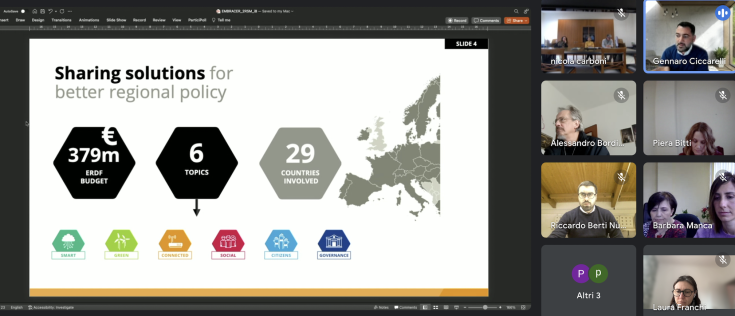New Stakeholders meeting held in Italy
On 27th February 2024, TTS Italia and the Metropolitan City of Cagliari held the second regional stakeholder meeting (online), which besides sharing key insights and update on EMBRACER progress and achievements - revolved around the exchange of good practices and project-oriented experiences concerning the integration of public transport with informal mobility modes (e.g., cycling, ride-hailing, car/bike/scooter sharing, on-demand transport, autonomous shuttles) to enhance the interconnection with urban areas and achieve seamless intelligent climate-resilient regional and local intermodal mobility. The meeting resulted in a particularly interested audience with more than 16 participants including several representatives from several Sardinia’s Municipalities, and public ICT and transport planning organisations.
Gennaro Ciccarelli chaired the meeting that started with a showcase of the state of the art of the EMBRACER project, including key challenges addressed, objectives, scope of work, the project consortium, progress updates and ongoing activities. After a first description of the Interreg Europe programme, Gennaro presented a brief overview of the role of European territorial cooperation. He then offered a quick portrait of the first Exchange of Experience event outcome, that took place in Rome.
During the following presentation, Barbara Manca, Mobility Councilor of Quartu Sant’Elena, briefly showcased the current state of the art and some of the infrastructural changes that have been brought forward within the city of Quartu, including investments in intiatives such as demand responsive transit, e-fleet renewal, car-sharing, scooter-sharing and bike-sharing initiatives. Subsequently, she presented some key activities that are being carried out in compliance with their SUMP (Sustainable Urban Mobility Plan).
Riccardo Berti Nulli, Sintagma srl, addressed the socio-demographic problem and the ageing process process affecting the city of Cagliari. He highlighted the core part of the SUMP: 22 actions, which goals is to gain about 15 to 18 % points towards sustainability and to increase the popularity of mobility sharing. As a first step for planning the actions, a survey campaign was conducted. The aim was to lower the mobility waves during the peak hours in favour of last-mile sharing systems. Among those 22 actions, there was the identification of the 8 mobility hubs: spaces conceived not only as exchange car parks for sharing, but safe and illuminated places; the protection of vulnerable users was fundamental: studies were carried out on 30 km/h zones and traffic calming interventions, to share the road surface also with pedestrians and cyclists; the proposal for the creation of a single App, the objective of which is to develop an infrastructure of ITS systems that, through an integrated central unit, are able to collect a huge amount of data, encode them and return them in a useful form to users.
Following, Proto Tilocca, ITS Città Metropolitana S.c.a r.l. highlighted the great difficulty in managing the complexity behind ITS systems following their implementation. As a result, the focus of his presentation was on the analysis of the activities carried out in recent years and the related expansion that has taken place over the years: from ITS systems to video surveillance and enforcement system covering the whole of the metropolitan city territory. Subsequently, he presented the Creation of technological infrastructures to support the implementation of the digital underground agenda of the Optic Fiber system and the management system of the city mobility, data transmission, communication, and radio communication. He states that raising stakeholder awareness on the proper management of resources is crucial today, motivated by an example from a simulation model from 2007. After implementing a series of interventions, the project came to an end. What was missing at the time and is still missing today are regulations and standards. Organisation and Skills. The organisational gap needs to be closed.
The last presentation, by Paolo Dileno, Central European Initiative - Executive Secretariat, focused on a specific weak area: the context of cross-border areas, which struggles with the problem related to different legislation on both sides of the border. When dealing with practices to connect urban and rural areas, he referred to a vicious cyclic process whereby low resources lead to a demographic decline, poor connectivity and low employment rates. Referring to the Interreg Central Europe SUSTANCE project, he identified what can be considered the ‘Winning Ingredients’ for improving rural-city connectivity: understanding the problem and stakeholder needs; stakeholders’ involvement, essential to design possible solutions in a bottom-up way and to move from ideation to execution; piloting initiatives as a powerful tool to support decision-making and long-term policies.
